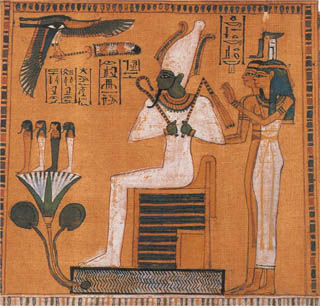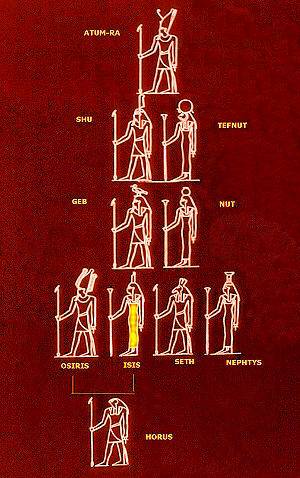
Mysteries of Isis and Osiris
Website Created by Phil Norfleet

|
|
Mysteries of Isis and OsirisWebsite Created by Phil Norfleet |
|

Every religion from every culture has it's own 'tale' of how the world was created and how their religion expanded. The Egyptians were no different.
A certain amount of order was brought to Egyptian mythology and its myriad of gods by the priests themselves. The result of this was the creation of a number of enneads, groups of nine gods and goddesses, usually organized into families. The number nine was a sacred and symbolic number that could also stand for 'all' gods. This was because the Egyptians indicated plurals by using three, and nine was thus perceived as the plural of plurals. Therefore, 'nine' should not always be taken literally, the ennead of Thebes, for example, consists of fifteen gods. The most important ennead was that of Heliopolis, often called the Great Ennead. At its head was Atum, the creator and sun god. His children Shu and Tefnut gave birth to the earth god Geb and the sky goddess Nut, who in turn were the parents of Osiris, Isis, Nephthys and Seth. Occasionally Horus is added to them as a tenth god, sometimes as the fifth generation (child of Osiris and Isis) and sometimes as Nut's fifth child. In the Pyramid Texts of the Old Kingdom there is already mention of the five children of Nut. Centuries later, Plutarch relates how the sun god Helios (as the Greeks called the sun god Re) put a curse on the goddess Rhea (the Greek name for Nut), forbidding her to give birth to her children on any of the 360 days of the year. Hermes (Thoth in Egyptian) then added five days to the year (the five epagomenal days of the Egyptian calendar) and on these days Nut gave birth to her five children. In addition to the Great Ennead, there was also the Small Ennead, the gods of which varied with the times. The Small Ennead of Heliopolis included Isis's son Horus, Anubis, Maat and Thoth. Another Small Ennead included the Four Sons of Horus and the children of Khentekhtai.
It is similar to other certain religions, or cultural ideas, such as some tribes
of Native Americans. The deities that created the start of everything were
called The Ennead (this name being of Greek origin). They were given this name,
a version from the Greek word ennea, meaning nine and as there were nine primary
deities, hence their collective name. They were also known as The Nine Gods of
Heliopolis, even though they were not all Gods.
The first of these is Ra - Atum, who came into being on the primeval mound and planned the multiplicity of creation in his heart. Notice that although in some religion, the creation of the first god is never really discussed, the Egyptians had an explanation for even the first of their numerous Deities. Ra - Atum created the first male and female by taking his semen into his mouth, he then sneezed (or spitted in some versions) the God, Shu - The God of Air and also Tefnet (or Tefernut) - The Goddess of Moisture.
These two deities explored the massive expanse of darkness, called Nun. After
many years of being without contact with the two deities (they were lost) Ra -
Atum, missing them, sent his Divine Eye (sometimes thought of as Hathur or even
Sekhmet), a fiery power, regarded as the daughter of the Sun God, to search for
Shu & Tefenet. The Goddess returned with Shu & Tefenet and humanity was first
created by the tears which Ra - Atum wept at being reunited with his Children.
From the sexual union between Shu & Tefenet, came the God, Geb - God of the
Earth and Nut, Goddess of the Sky. These two embraced so closely to one another
that there was no room for anything between them to live or breathe. Nut became
pregnant by Geb but there wasn't room for her children to be born so Shu came
between the two, Geb & Nut. With the aid of eight beings known as the Heh Gods,
Shu was able to hold up Nut, away from Geb, creating room for humans to live on
earth and with air to breathe. There was also thought to be another sky under
the earth. Nut sometimes took on the appearance of a naked woman and was said to
swallow the Sun each evening, and was also thought to want to swallow her own
children.
Because of this Nut was often pictured as a sow, an animal notorious for wanting to eat her own farrow (litter of pigs). Nut had two sets of Twins, Osiris and Isis and then Nephthys and Seth (or Set). Orisis and Isis fell in love with each other in Nuts womb but Nephthys despised her brother, Seth. Nephthy's dislike of her twin, Seth, brought about many myths by itself. Due to the dislike of Seth but for the love of her brother Osiris, Nephthys helps Isis to mummify Osiris and also to bring him from the dead. In later myths Nephthys also has a child to Osiris - the Jackal deities, Anubis, the God of Embalming, so again, links to embalming and the raising of the dead, son helping father, as with Horus & Osiris.